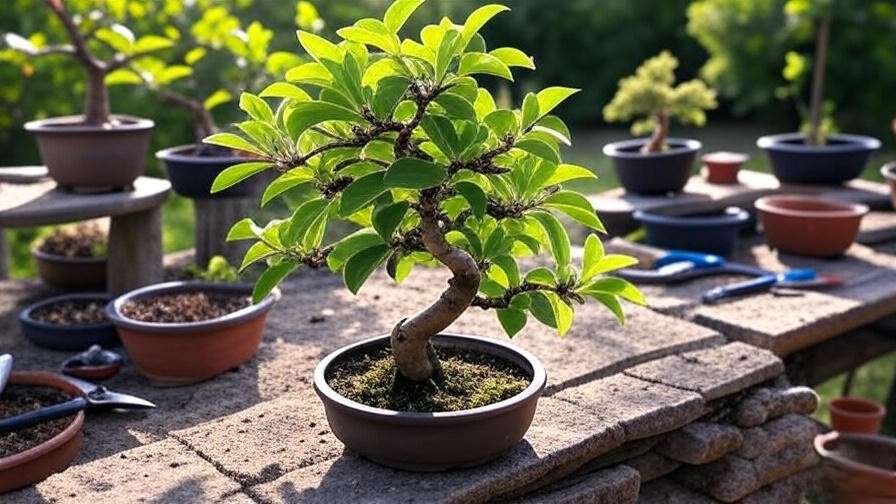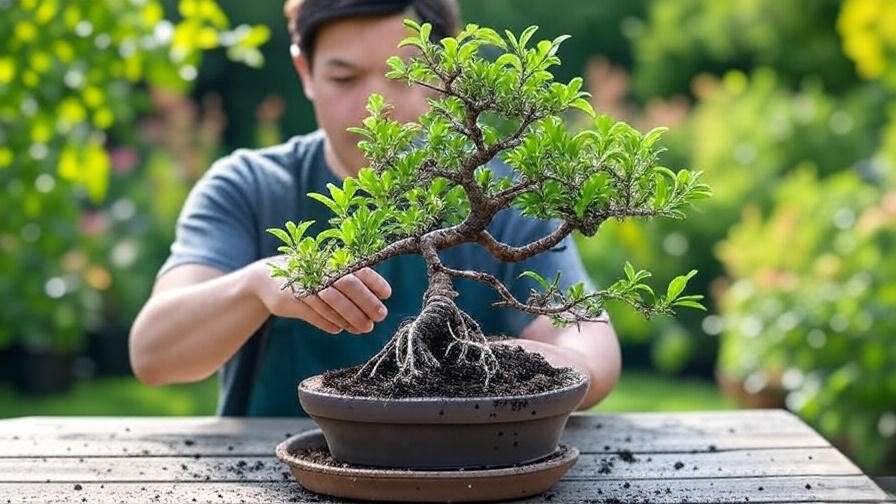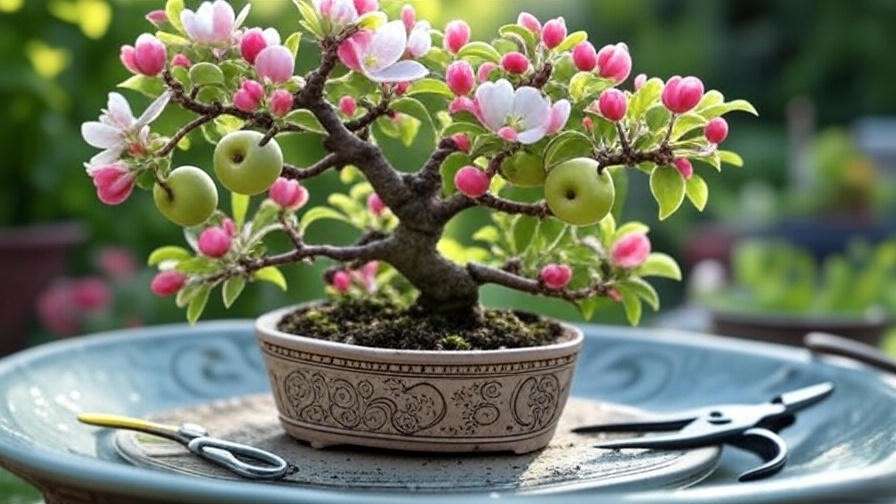Imagine a tiny apple tree bonsai gracing your home, its delicate branches adorned with vibrant blossoms and miniature apples that captivate the eye and warm the heart. This living artwork blends the elegance of bonsai with the joy of growing edible fruit, making it a rewarding pursuit for plant lovers. Whether you’re a beginner or a seasoned bonsai enthusiast, mastering apple tree bonsai care unlocks a world of beauty and satisfaction. In this comprehensive guide, we’ll explore everything you need to know to grow and maintain a thriving apple tree bonsai, from selecting the perfect tree to encouraging stunning blooms and fruit. With expert tips and step-by-step advice, you’ll be equipped to nurture your own miniature masterpiece. 🌱
As a horticulturist with over a decade of experience in bonsai cultivation, I’ve drawn on insights from the American Bonsai Society and university extension programs to craft this guide. Let’s dive into the art and science of apple tree bonsai care! 🌟
1. Understanding Apple Tree Bonsai: What Makes It Special? 🍏
1.1 The Charm of Apple Tree Bonsai 🌟
Apple tree bonsai, derived from Malus species, are a unique fusion of ornamental beauty and functional fruit production. Unlike traditional bonsai like junipers or maples, apple tree bonsai offer delicate pink or white blossoms in spring, followed by tiny, edible apples in late summer or fall. Their compact size—typically 12 to 36 inches tall—makes them ideal for small spaces, while their seasonal changes add dynamic beauty to any setting. The emotional reward of nurturing a tree that blooms and fruits is unmatched, blending the patience of bonsai artistry with the thrill of harvesting miniature apples. 🍎
1.2 Popular Apple Tree Varieties for Bonsai 🌿
Not all apple trees are suited for bonsai, but several varieties shine in this art form. Here are some beginner-friendly options:
- Malus domestica ‘Fuji’: Known for its sweet, crisp apples and vibrant spring blooms.
- Malus domestica ‘Gala’: Compact growth and small, colorful fruit perfect for bonsai aesthetics.
- Crabapple (Malus sylvestris): Hardy, with profuse blossoms and tiny apples ideal for miniature displays.
These varieties are chosen for their manageable size, attractive foliage, and ability to produce flowers and fruit in confined root systems. According to bonsai expert John Naka, “The right variety sets the foundation for a bonsai that thrives both aesthetically and functionally.” Always select a variety suited to your climate and skill level. 🌳
2. Getting Started: Selecting and Preparing Your Apple Tree Bonsai 🌱
2.1 Choosing the Right Tree 🌳
Selecting a healthy apple tree is the first step to bonsai success. Look for a young tree (1–3 years old) with a flexible trunk, well-distributed branches, and a robust root system. Nurseries specializing in bonsai or fruit trees, such as Bonsai Boy or local garden centers, are great sources. Online retailers like Amazon or Etsy also offer pre-bonsai stock. Check for vibrant leaves, no signs of pests, and a trunk with potential for shaping. Avoid trees with overly thick trunks, as they’re harder to style into bonsai form. 🪴

2.2 Essential Tools and Materials 🛠️
To care for your apple tree bonsai, you’ll need:
- Pruning shears: For precise trimming of branches and roots.
- Concave cutters: To create clean cuts that heal smoothly.
- Bonsai wire: For shaping branches into desired forms.
- Well-draining soil mix: A blend of akadama, pumice, and organic compost (e.g., 50% akadama, 30% pumice, 20% compost).
- Bonsai pot: Shallow, with drainage holes to prevent waterlogging.
Checklist for Beginners:
- Purchase quality tools from a reputable brand like Tian Bonsai.
- Prepare a soil mix tailored for fruiting trees.
- Choose a pot that complements your tree’s aesthetic. 🌿
3. Step-by-Step Care Guide for Apple Tree Bonsai 🌞
3.1 Light and Location ☀️
Apple tree bonsai thrive in full sun, requiring 6–8 hours of direct sunlight daily to support photosynthesis, blooming, and fruiting. Place your bonsai outdoors in a sunny spot, such as a patio or garden, during spring and summer. In colder climates, protect it from harsh winds or frost by moving it to a sheltered area. For indoor placement, use a south-facing window or supplement with a grow light (e.g., 6500K LED, 12 hours daily). A common mistake is insufficient light, which leads to weak growth and poor flowering. Ensure your bonsai gets ample sunshine to flourish. 🌞
3.2 Watering Needs 💧
Proper watering is critical for apple tree bonsai. Keep the soil consistently moist but not soggy, as waterlogged roots can lead to rot. Water when the top inch of soil feels dry, typically every 1–2 days in warm weather. Use a watering can with a fine nozzle to avoid disturbing the soil. Signs of overwatering include yellowing leaves and mushy roots, while underwatering causes wilting or leaf drop. Pro Tip: Invest in a moisture meter to gauge soil dampness accurately, ensuring your bonsai stays hydrated without drowning. 💦
3.3 Soil and Fertilization 🌍
A well-draining soil mix is essential for apple tree bonsai to prevent root rot and promote healthy growth. A recommended mix is 50% akadama, 30% pumice, and 20% organic compost, providing aeration and nutrient retention. Fertilize every two weeks during the growing season (spring to early fall) with a balanced fertilizer (e.g., 10-10-10 NPK) to support foliage and roots. Switch to a potassium- and phosphorus-rich fertilizer (e.g., 5-10-10) in late summer to boost blooming and fruiting. Research from the University of California Extension emphasizes the importance of balanced nutrients for fruiting bonsai. Avoid over-fertilizing, as it can burn roots. 🌱
3.4 Pruning and Shaping ✂️
Pruning is the heart of bonsai artistry. Structural pruning shapes the tree’s overall form, removing large branches to create a balanced silhouette. Perform this in late winter before new growth begins. Maintenance pruning keeps the tree tidy, pinching back new shoots to 2–3 leaves after they reach 5–6 leaves. Wiring helps shape branches, but use aluminum wire to avoid damaging delicate bark. Apply wire in spring when branches are flexible, and remove it after 2–3 months to prevent scarring. Prune and wire in early spring or late fall to align with the tree’s growth cycle. 🌿

3.5 Repotting Basics 🪴
Repotting maintains root health and keeps your bonsai’s size in check. Young apple tree bonsai need repotting every 2–3 years, while mature trees can go 3–5 years. Repot in early spring before buds swell. Step-by-Step Repotting:
- Gently remove the tree from its pot.
- Trim 1/3 of the root mass, focusing on thick, woody roots.
- Place fresh soil mix in the pot, position the tree, and fill with more soil.
- Water thoroughly and keep the tree in partial shade for 2 weeks.
This process ensures healthy roots and sustained growth. 🪴

4. Encouraging Blooms and Fruit Production 🍎
4.1 Promoting Flowering 🌸
Apple tree bonsai require a period of winter dormancy (chilling hours at 32–45°F) to trigger spring blooms. In mild climates, simulate this by placing the tree in a cool garage or refrigerator for 4–6 weeks. For indoor trees, hand-pollination with a small paintbrush ensures flower fertilization, as natural pollinators may be limited. A bonsai enthusiast, Sarah T., shared, “Hand-pollinating my ‘Gala’ bonsai led to a burst of blooms in its second year!” Ensure adequate sunlight and nutrients to support flowering. 🌸
4.2 Supporting Fruit Development 🍏
Once flowers are pollinated, small apples will form. Use a potassium-rich fertilizer (e.g., 5-10-10) to support fruit development. Thin fruit to 1–2 per cluster to prevent branch stress and ensure larger, healthier apples. Fun Fact: Miniature apples are edible and make charming additions to desserts or displays. Regular monitoring prevents overproduction, which can weaken the tree. 🍎
5. Seasonal Care for Apple Tree Bonsai 🍂
5.1 Spring and Summer Care 🌞
Spring and summer are the peak growing seasons for your apple tree bonsai. During this time, focus on promoting vigorous growth and maintaining health. Increase watering frequency to keep the soil consistently moist, especially during hot summer days. Apply a balanced fertilizer (10-10-10 NPK) every two weeks to support leaf and branch development. Prune new shoots regularly to maintain the desired shape and encourage dense foliage. Monitor for pests like aphids or spider mites, which thrive in warm weather. Regular inspection and a quick spray of neem oil can keep these pests at bay. Place your bonsai in a spot with full sun to maximize photosynthesis and prepare the tree for blooming. Tip: Rotate the pot every few weeks to ensure even light exposure. 🌱
5.2 Fall and Winter Care ❄️
As fall approaches, your apple tree bonsai prepares for dormancy, a critical phase for its health and future blooming. Reduce watering as growth slows, ensuring the soil doesn’t dry out completely. Stop fertilizing by late fall to avoid stimulating new growth that could be damaged by cold. In colder climates (below 32°F), protect your bonsai from frost by moving it to a sheltered area, such as an unheated garage or a cold frame. Wrap the pot in burlap or add a layer of mulch to insulate the roots. For indoor bonsai, maintain cool temperatures (40–50°F) to mimic natural dormancy. Pro Tip: Check soil moisture weekly during winter, as even dormant trees need occasional watering. ❄️

6. Troubleshooting Common Issues 🐛
6.1 Pests and Diseases 🦟
Apple tree bonsai are susceptible to common fruit tree pests and diseases, but early detection and treatment can keep them healthy. Common Pests:
- Aphids: Small, sap-sucking insects that cause leaf curling. Treat with neem oil or insecticidal soap.
- Spider Mites: Tiny pests causing stippled leaves. Increase humidity and spray with water or miticide.
- Apple Scab: A fungal disease causing dark spots on leaves and fruit. Remove affected leaves and apply a copper-based fungicide.
Expert Advice: Adopt integrated pest management (IPM) techniques, such as encouraging beneficial insects like ladybugs, to control pests naturally. Regular inspection, especially under leaves, helps catch issues early. 🐞
6.2 Growth Problems 🌱
If your apple tree bonsai shows signs of distress, diagnose the issue systematically:
- Yellowing Leaves: Often due to overwatering, poor drainage, or nutrient deficiency. Check soil moisture and adjust watering or fertilizing.
- Lack of Blooms: May result from insufficient chilling hours or inadequate sunlight. Ensure proper winter dormancy and full sun exposure.
- Stunted Growth: Could indicate root-bound conditions or lack of nutrients. Repot if roots are circling the pot, and review fertilization practices.
Case Study: A bonsai grower in Oregon revived a struggling apple tree bonsai by repotting it in a well-draining soil mix and moving it to a sunnier location, resulting in vibrant blooms the following spring. Use this diagnostic approach to pinpoint and resolve issues. 🌿
7. Advanced Techniques for Stunning Apple Tree Bonsai 🎨
7.1 Refining Aesthetic Appeal 🖌️
To elevate your apple tree bonsai into a true work of art, focus on advanced styling techniques. Experiment with classic bonsai styles like informal upright (moyogi) or cascade (kengai) to create dramatic silhouettes. Use precise wiring to shape branches, ensuring gentle curves that mimic natural growth. To enhance the tree’s aged appearance, encourage bark texture by allowing the trunk to thicken gradually over years. Inspiration: Award-winning apple tree bonsai at the National Bonsai Exhibition often feature gnarled trunks and balanced canopies, showcasing years of careful shaping. Study these examples to refine your technique. 🌳

7.2 Propagating Your Own Bonsai 🌱
Creating your own apple tree bonsai from scratch is a rewarding challenge. Propagation Methods:
- Seeds: Soak apple seeds for 24 hours, stratify in a refrigerator for 6–8 weeks, then plant in a seed-starting mix. Expect 3–5 years before shaping begins.
- Cuttings: Take 6-inch semi-hardwood cuttings in summer, treat with rooting hormone, and plant in a moist, sandy mix. Roots form in 4–6 weeks.
- Grafting: Graft a desired apple variety onto a hardy rootstock for unique traits. This requires precision but yields faster results.
Pro Tip: Propagation takes patience, but starting from a seed or cutting allows you to shape the tree from its earliest stages, creating a deeply personal bonsai. 🌱
8. FAQs About Apple Tree Bonsai ❓
- Q1: Can apple tree bonsai bear edible fruit?
Answer: Yes, with proper care, the miniature apples are edible and safe, perfect for small snacks or decorative use. 🍎 - Q2: How long does it take for an apple tree bonsai to bloom?
Answer: Typically 2–3 years with consistent care, including proper chilling and sunlight. 🌸 - Q3: Is apple tree bonsai suitable for beginners?
Answer: Yes, but they require attention to watering, pruning, and seasonal care. Start with a hardy variety like crabapple. 🌿 - Q4: How do I protect my bonsai from pests?
Answer: Regular inspections and neem oil sprays are effective. Encourage natural predators like ladybugs for organic control. 🐞 - Q5: Can I keep my apple tree bonsai indoors year-round?
Answer: Outdoor placement is ideal for natural light and dormancy, but indoor care is possible with grow lights and cool temperatures in winter. ☀️
9. Conclusion: Your Journey with Apple Tree Bonsai 🌟
Growing an apple tree bonsai is a journey of patience, creativity, and connection with nature. By selecting the right tree, providing consistent care, and mastering techniques like pruning and pollination, you can create a stunning miniature tree that blooms and bears fruit. Whether you’re shaping delicate branches or harvesting tiny apples, each step deepens your appreciation for this living art form. Start your bonsai adventure today, and share your progress with fellow enthusiasts in local or online bonsai communities. For more tips, explore our articles on bonsai pruning or fruit tree fertilization. Here’s to cultivating your own masterpiece! 🌳🍏













